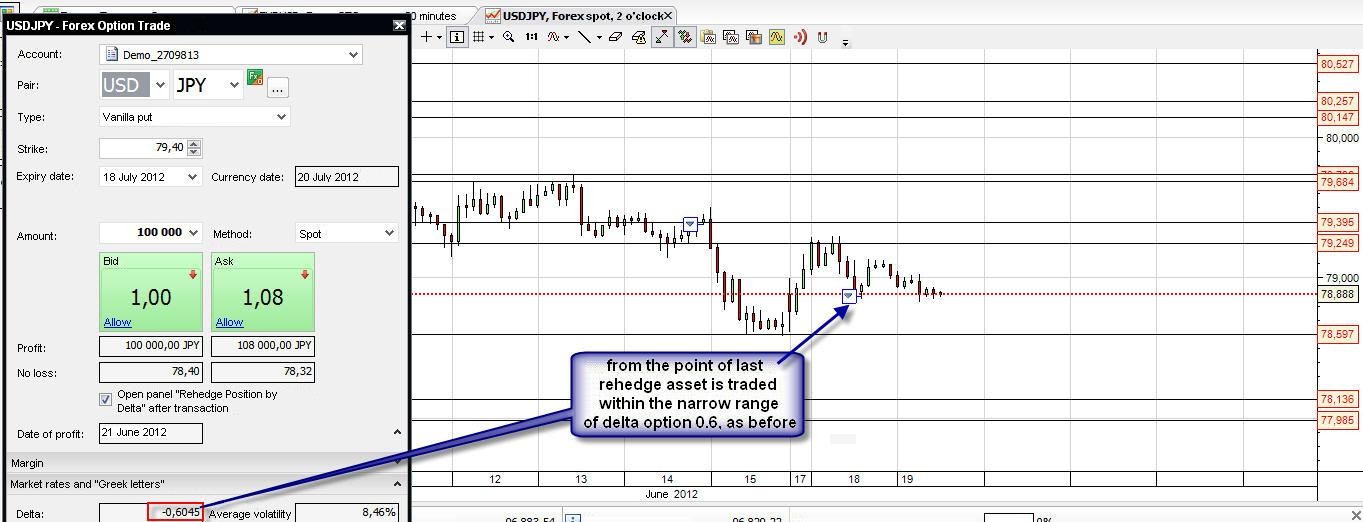Delta Neutral Direction Doesn t Matter
Post on: 23 Апрель, 2015 No Comment

Options Expert
Anyone, who knows anything about options trading, knows that to make profits on a consistent basis you have to predict something. The days of arbitrage trading for the public customer are long since gone, and in fact, even market makers and other professionals cant make a business strictly out of finding profitable arbitrage positions. Generally, the predictions fall into one of two categories, making directional predictions or volatility predictions. Either way probably can work, although most of the successful options traders that I know make their trades based on volatility, as do I.
A key component of volatility trading is the concept of delta neutral. If youve been in this business for any length of time Im sure youve heard the term, but do you really know what it means and how and when its used?
Definition: An options position on a particular stock is said to be delta neutral if it consists of various options and possibly stock such that the total of the positive and negative deltas of the options and stock net out to zero, or very close to zero.
The consequence of having a position that is delta neutral is that for small changes in the price of the stock, the total value of the position does not change. Note the emphasis on the word small. In effect, by making a position delta neutral we have eliminated, or at least reduced, the impact of a change in the value of the stock on the value of the position.
Lets look at an example:
XYZ stock is trading at $55 and the Sep 60 Calls @ 3.50 with a delta of 40. The implied volatility of the option is 45 which I think is too low, relative to prior historical and implied volatility levels, and will be increasing. I decide to buy 10 of the Calls, and make the position delta neutral. In that way, Ill be eliminating the impact of any small change in the price of the stock on the position and can focus in on the volatility.
The 10 Calls will have a total delta of 400, so to make the position delta neutral I need to eliminate 400 deltas. One way to do this is to sell short 400 shares of stock. The following table illustrates that for this delta neutral position with the stock at $55, the position is put on for a net credit of $18,500. As you can see, if the price decreases to $54 or increases to $55.50 the value of the position does not change.
Larger changes in the price of the stock will start to have an impact on the position total, because as the price of the stock changes the delta of the option is changing as well. So, for instance, if the price of the stock rose to $60, my theoretical options pricing calculator tells me that the value of the Call will be $6. That means that the Calls would be worth $6,000 and the short shares $-24,000, for a net position value of $-18,000.
What happened here is that the Calls increased in value more than the 40 delta would have indicated. Applying the 40 delta to a $5 increase in the price of the stock (from $55 to $60) we would expect the price of the option to increase from $3.50 to $5.50, but instead it actually went to $6. Why? Its because of the gamma of the option. As the stock is increasing, the delta of the Call option is also increasing. The same situation would happen if the stock went down a considerable amount. The gamma would cause the Call option to lose value.
As far as delta neutral goes, it looks like we have a problem if the stock moves too much. So what can we do? Thats easy, we make an adjustment to the position to make it delta neutral again! In this example with the stock at $60 the new delta for the option is 50 or 500 â 400 = 100 for the position. So to stay delta neutral, I can sell another 100 shares of stock. Keep in mind that selling shares is not the only way to neutralize long deltas. I could also buy Puts, or sell other Calls. Analogously, if the position was short deltas, I could neutralize by buying stock, buying Calls, or selling Puts.
In the example, the reason I chose to short stock is because buying or selling stock does not affect any of the Greeks aside from delta. Thats right, stock does not have any gamma, vega, theta or rho. If I neutralized the position by buying Puts or selling Calls, it would have changed the characteristics of the position in a way that might not be what I was looking for.

Something else to be aware of is that as time goes by a position will also become less delta neutral. This particular position will retain its neutral status for about 2 weeks before there is a significant change in its delta position. However, other positions may be more sensitive to time. Finally, a change in volatility will also cause a position to lose its neutrality, although again, different positions will be more or less sensitive to a change in volatility.
Either way, its not a big deal to keep a position delta neutral with the purchase and sale of stock. Of course, an alternative method to using stock would be to use synthetic stock to make the adjustments. Short deltas could be neutralized by buying a Call and selling a Put for each 100 deltas. Long deltas would be neutralized by selling a Call and buying a Put.
The real question is not how to keep a position delta neutral, thats fairly easy, but rather when to make the adjustments. This is where some art gets mixed in with the science. Some traders will make adjustments when the stock moves a certain number of points, or when the deltas exceed some pre-set limit, or at some regular interval of time. The less disciplined trader will just make the adjustments when it feels right. I dont buy that approach. I believe a plan, even a plan thats not great, is better than no plan. If the plan isnt working it can always be modified.
Going back to the original example, I put the trade on because I thought the current volatility of 45 was too low for this XYZ stock. I was predicting that the volatility would increase at least 20 points to 65 or more. Since the vega for the Calls was 12.50 and I did 10 contracts, I expect to make 12.50 x 10 = $125 on this trade. In reality, I would never put on a position of this size with the expectation of making only $125. After transaction costs, even in a best case scenario, I would end up with very little profit. A more palatable trade might be to buy the Calls and then buy the appropriate number of low volatility Puts to neutralize the position. This will provide me with a delta neutral position, but with more sensitivity to volatility, i.e. a higher vega. Adjustments would be made as needed using synthetic stock. When the volatility reached my target, I would take the position off and enjoy the profit. If the volatility did not change, I would hope to not suffer much of a loss.
For now, Ill mention a few final points regarding delta neutral trading. First, its not very practical to think that you can get the total deltas to be exactly equal to zero. Some traders only consider a position to be neutral if it has between -99 and 99 deltas. Others may consider a position to be delta neutral if the position has several hundred deltas. It depends on the size of the trade and the amount of directional risk that youre willing to absorb. Second, keep in mind that these numbers are soft. In other words, the deltas are calculated based on a set of imprecise assumptions and while theyre obviously useful, they are a blunt tool and not a precision instrument. Nothing makes me laugh more than seeing screen monitor real estate being wasted by showing deltas (and the other Greeks) to 5 or 6 decimal places. Theyre just not that precise.
Finally, while delta neutral is a great concept, when stocks are very volatile and moving around a lot, a position doesnt stay neutral for very long. The next step to eliminating the directional component would be to make the position not only delta neutral, but gamma neutral as well! A position like that would be neutral over a wider range of prices and a longer period of time. For now, just think about it. Ill provide the details in a future article.
As always, if you have any questions about my articles, have suggestions for future topics, or want more information about our options mentoring program, feel free to email me at: sfreifeld@tradingacademy.com or call me at: (888) OTA-2580 ext. 2010.














